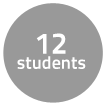Instructor Insights pages are part of the OCW Educator initiative, which seeks to enhance the value of OCW for educators.
Course Overview
This page focuses on the course 22.S902 Do-It-Yourself (DIY) Geiger Counters as it was taught by Prof. Michael Short in IAP 2015.
This experimental one-week course, offered during the January IAP term ![]() , is a freshman-accessible hands-on introduction to Nuclear Science and Engineering at MIT. Students build and test their own Geiger Counter, and in so doing, they explore different types and sources of radiation, how to detect them, how to shield them, and how to accurately count/measure their activity. This course is meant to be enjoyable and rigorous at the same time.
, is a freshman-accessible hands-on introduction to Nuclear Science and Engineering at MIT. Students build and test their own Geiger Counter, and in so doing, they explore different types and sources of radiation, how to detect them, how to shield them, and how to accurately count/measure their activity. This course is meant to be enjoyable and rigorous at the same time.
Course Outcomes
Course Goals for Students
Learning objectives:
- Understand types of radiation: alpha, beta, gamma, neutrons and others
- Describe characteristics of natural and man-made radiation sources
- Predict the type and energy of radiation for different reactions
- Explain principles of radiation shielding
- Interpret detector theory and limitations
- Gain exposure to statistics, uncertainty, and error analysis as applied to Geiger counters
- Understand implementation issues: circuit theory, sources of error and dead time
Laboratory objectives:
- Learn how to solder and assemble circuits
- Develop testing and debugging skills
- Understand sources of experimental error
- Plan experimental procedures for faster success
Possibilities for Further Study/Careers
This course prepares students to start undergraduate work in nuclear science and engineering. It exposes them to buzzwords and key concepts. The course also enables them to test a few of these concepts. This is important, because the fundamentals of nuclear science are typically not taught in high schools.
The course also provides students with the fundamentals needed for the study of radiation physics. Students interested in pursuing radiology or interstellar radiation will find it useful.
This is the class in which I want to see things exploding. This is where I want to see you do the high-voltage dance. This is where I want everything to go wrong, because you can’t get it to go right unless you see what goes wrong.
—Michael Short
In the following pages, Prof. Michael Short describes various aspects of how he taught 22.S902 Do-It-Yourself (DIY) Geiger Counters.
- Course History and Future Iteration
- Developing and Teaching Hands-on Courses
- Learning to Ask the Questions
- Keeping Students Interested, and Talking
- The After Life of Geiger Counters
Curriculum Information
Prerequisites
None
Requirements Satisfied
None
Offered
This was a first-time experimental offering during IAP.
Assessment
The students' grades were based on the following activities:
 25% Problem sets
25% Problem sets 25% Lab report
25% Lab report 50% Successfully building a working Geiger counter
50% Successfully building a working Geiger counterInstructor Insights on Assessment
In assessing student learning, we attended to whether or not students accounted for experimental error in their work. We wanted to know if they were thinking about statistics, or just writing down the numbers generated by the counters. We checked to see if they were thinking critically about the data. For example, if students got a background count of 0, we didn’t want them to assume that that number meant there was no radiation in the room. We wanted them to consider the fact that something may have gone wrong with their experiment, such as a loose wire. These were the kinds of things that we paid attention to in our grading.
Student Information

Breakdown by Year
1/2 freshmen, 1/2 graduate students. Several visiting graduate students from SUTD (Singapore University of Technology and Design) also participated.
Ideal Class Size
The bigger the better, up to about 25-30 students (assuming 2 or 3 talented TAs).
This was a one-week course, in which students were expected to spend approximately 40 hours, divided as follows:
In Class
- Met 4 hours a day for one week; 5 total sessions.
- Interactive lectures.
- Hands-on lab experiences; students built their Geiger counters from kits and used the counters to run experiments.
Out of Class
Semester Breakdown
| WEEK | M | T | W | Th | F |
|---|---|---|---|---|---|
| 1 |  |  |  |  |  |
 No classes throughout MIT
No classes throughout MIT Lecture session
Lecture session Assignment due date
Assignment due date No class session scheduled
No class session scheduled Lab session
Lab sessionMain Instructor (Prof. Michael Short)
- Developed and delivered lecture content.
- Assessed students’ work.
- Assisted students during lab.
Teaching Assistants (Mark Chilenski and Matthew D’Asaro)
- Mark Chilenski designed the Geiger counter hardware and instruction manual. Delivered lectures about how the Geiger counter works.
- Matthew D’Asaro designed software that allows users to digitize counts and export them into an Excel file.
- Both TAs assisted students during labs.
- To learn more about Mark Chilenski and Matthew D’Asaro, please see the MIT Technology Review article, “A Dormitory Laboratory: Grad students Matthew D’Asaro and Mark Chilenski have turned their dorm room into an engineering workshop.”


 Room 1 of 2
Room 1 of 2 
